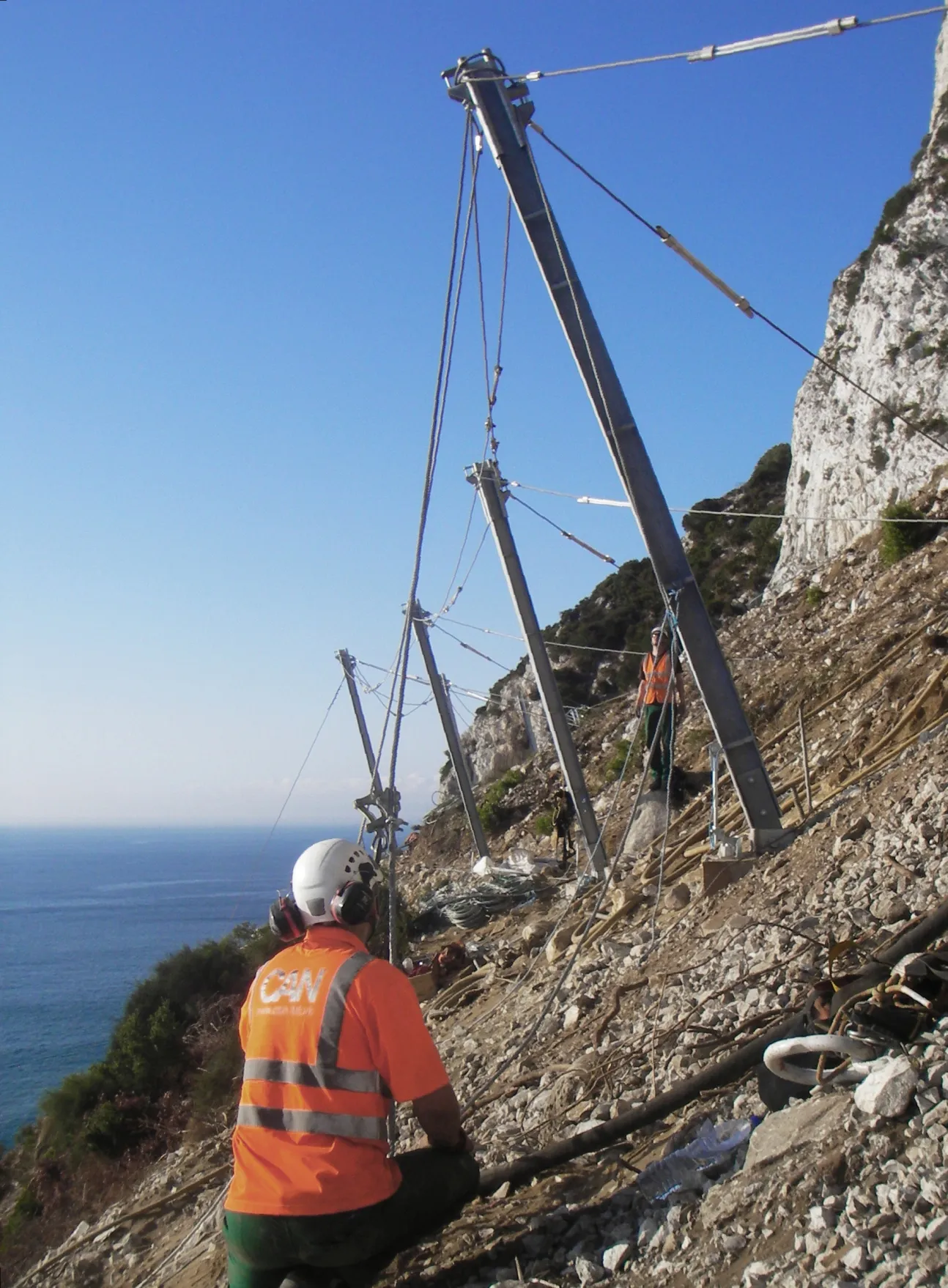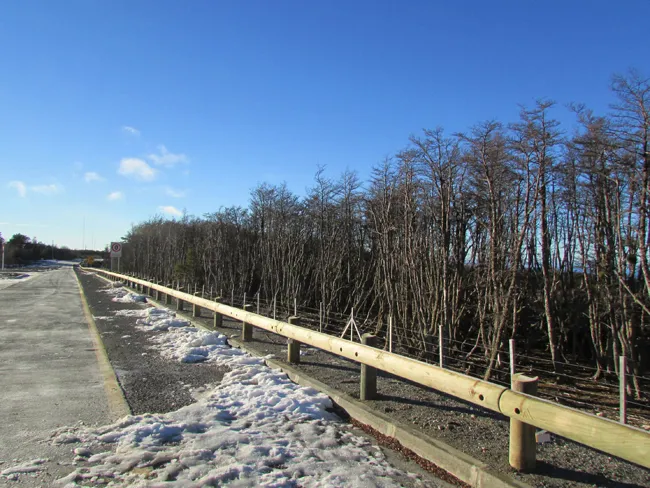In Gibraltar, where the entire population lives on or close to the huge limestone rock that gives the nation its name, the issue of rock fall protection is taken very seriously.
Here, a scheme to install a network of rock fall catchment fences has just been completed, which will allow the re-opening of a critically important road at the south-eastern end of the Rock, which was closed following a significant rock fall occurrence in 2002.
February 6, 2012
Read time: 4 mins

In Gibraltar, where the entire population lives on or close to the huge limestone rock that gives the nation its name, the issue of rock fall protection is taken very seriously.
Here, a scheme to install a network of rock fall catchment fences has just been completed, which will allow the re-opening of a critically important road at the south-eastern end of the Rock, which was closed following a significant rock fall occurrence in 2002.
Dave Crowther technical manager for rock fall protection specialists,1589 Maccaferri explains.
The potential dangers of rock fall in this and other areas of the Rock were already known and the Gibraltar government had previously commissioned consultants1590 Golder Associates to advise them on rock fall protection.
Consequently, Golder Associates proposed a combination of mitigation measures to provide protection for the 500m long stretch of road leading up to the Dudley Ward Tunnel entrance, site of the previous rock fall incident. These included an extended rock fall canopy over the tunnel entrance, passive rock fall catch ditches cut into the lower slope immediately above the road, and a network of high resistance catch fences.
The catch fence scheme, valued at some £1 million (E1.1 million) was undertaken by contractor1593 CAN Geotechnical. Three fences were installed; firstly a 200m long section split into three lengths, plus a second 70m long and a third 90m long run.
The element design and supply of the catch fences was put to Oxford, UK-based rock fall protection specialists Maccaferri, who proposed a network of the company's 5m high, CTR 30-04-A Barriers, capable of withstanding 3,000kJ (kilojoules) impacts. This is one of the company's highest capacity barriers, the highest being capable of containing impacts of up to 5,000kJ, the equivalent of stopping a 16.5tonne truck travelling at over 90km/hour.
Catch fence design is now a sophisticated, high-tech process with the development of ever-more efficient systems, capable of absorbing huge amounts of kinetic energy caused by falling debris, [measured in kilojoules/kJ]. Much of the development work is European lead and has resulted in the adoption of a new European testing methodology, ETAG 027 (the European Technical Approval Guideline 027), which sets out the minimum standards for the manufacture, performance and testing of rock fall protection barrier systems used throughout the EU. It also forms the basis of the CE approval process so only rock fall protection systems which pass ETAG 27 can gain CE approval. Compliance will become a legal requirement across Europe.
The Maccaferri system, which is ETAG 027 compliant, comprises a network of continuous, high-strength steel wire, ring panels suspended at 10m intervals from 5m high steel posts. The posts are an integral part of the system but also act as independent components so if one is struck and damaged, adjacent posts accommodate the additional loadings.
The fence panels are positioned down-slope with steel cables fixed to back-stay anchors, securely fixed in a reversed v-formation, up-slope of the fence run. The 5m high fence posts are fixed to articulating brackets which are attached to substantial concrete head-blocks.
During an impact, the system ensures that the energy of the falling rock is dissipated and the rock is prevented from moving any further down the slope. Impact forces are shared among spans so that the stresses on the individual system components are minimised.
Energy dissipaters fitted to the post heads, help absorb impact shock loads. These dissipaters work by absorbing the applied energy by deformation and not by friction.
The catch fence components were supplied to site in prefabricated kits These kits come with the majority of connections, cables and related components factory-fitted to minimise installation variations.
Here, a scheme to install a network of rock fall catchment fences has just been completed, which will allow the re-opening of a critically important road at the south-eastern end of the Rock, which was closed following a significant rock fall occurrence in 2002.
Dave Crowther technical manager for rock fall protection specialists,
The potential dangers of rock fall in this and other areas of the Rock were already known and the Gibraltar government had previously commissioned consultants
Consequently, Golder Associates proposed a combination of mitigation measures to provide protection for the 500m long stretch of road leading up to the Dudley Ward Tunnel entrance, site of the previous rock fall incident. These included an extended rock fall canopy over the tunnel entrance, passive rock fall catch ditches cut into the lower slope immediately above the road, and a network of high resistance catch fences.
The catch fence scheme, valued at some £1 million (E1.1 million) was undertaken by contractor
The element design and supply of the catch fences was put to Oxford, UK-based rock fall protection specialists Maccaferri, who proposed a network of the company's 5m high, CTR 30-04-A Barriers, capable of withstanding 3,000kJ (kilojoules) impacts. This is one of the company's highest capacity barriers, the highest being capable of containing impacts of up to 5,000kJ, the equivalent of stopping a 16.5tonne truck travelling at over 90km/hour.
Catch fence design is now a sophisticated, high-tech process with the development of ever-more efficient systems, capable of absorbing huge amounts of kinetic energy caused by falling debris, [measured in kilojoules/kJ]. Much of the development work is European lead and has resulted in the adoption of a new European testing methodology, ETAG 027 (the European Technical Approval Guideline 027), which sets out the minimum standards for the manufacture, performance and testing of rock fall protection barrier systems used throughout the EU. It also forms the basis of the CE approval process so only rock fall protection systems which pass ETAG 27 can gain CE approval. Compliance will become a legal requirement across Europe.
The Maccaferri system, which is ETAG 027 compliant, comprises a network of continuous, high-strength steel wire, ring panels suspended at 10m intervals from 5m high steel posts. The posts are an integral part of the system but also act as independent components so if one is struck and damaged, adjacent posts accommodate the additional loadings.
The fence panels are positioned down-slope with steel cables fixed to back-stay anchors, securely fixed in a reversed v-formation, up-slope of the fence run. The 5m high fence posts are fixed to articulating brackets which are attached to substantial concrete head-blocks.
During an impact, the system ensures that the energy of the falling rock is dissipated and the rock is prevented from moving any further down the slope. Impact forces are shared among spans so that the stresses on the individual system components are minimised.
Energy dissipaters fitted to the post heads, help absorb impact shock loads. These dissipaters work by absorbing the applied energy by deformation and not by friction.
The catch fence components were supplied to site in prefabricated kits These kits come with the majority of connections, cables and related components factory-fitted to minimise installation variations.









